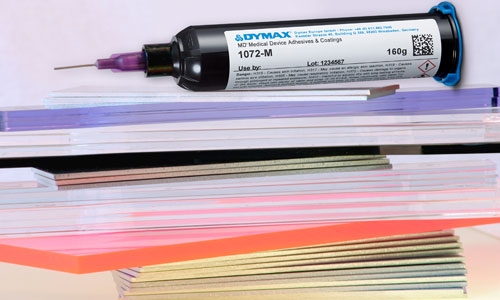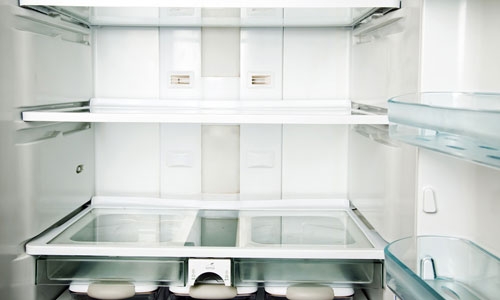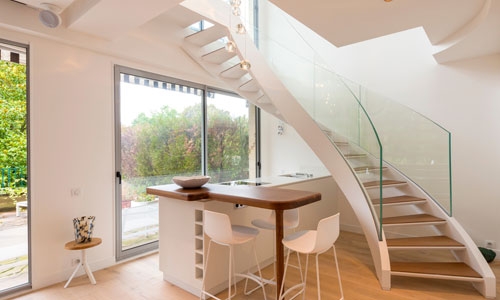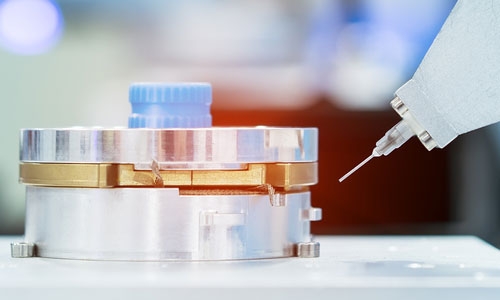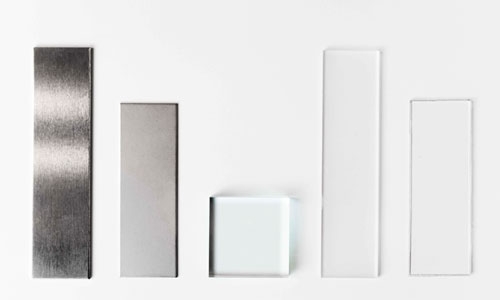Why Light-Curable Adhesives Excel in Structural Assembly
Achieving reliable bonds to diverse substrates has long been a challenge for manufacturers. The advent of UV/Visible light-cure technology revolutionized the way parts are assembled, replacing mechanical fastening methods such as rivets, screws, nuts, flanges, and bolts with adhesives and other light-curable materials such as coatings, potting compounds, and gasket sealants. Light-curable adhesives (LCAs) offer fast curing, precise control, and placement, exceptional bond strength, and the capability of easily joining glass, plastic, metal, and dissimilar substrates together.
Plastic Bonding Adhesives
Plastics are the building blocks for millions of products, and their chemical makeup can make bonding to them challenging. Sometimes substrates have low surface energy, such as high- and low-density polyethylene (HDPE and LDPE), so assembling or even coating them can be difficult, if not impossible. Additionally, curing through UV-blocked plastics or bonding dissimilar substrates can be tricky. However, since LCAs utilize light energy to cure them, they are exceptional for assembling translucent and transparent plastic components and disparate materials.
UV-curing plastic bonding adhesives adhere to plastic materials ranging from polycarbonate (PC) and polyethylene terephthalate (PET) to various acrylics (PMMA). These adhesive systems enable the creation of durable and visually appealing assemblies while maintaining the desired optical properties of the plastics.
Some key performance properties design engineers consider when searching for adhesives for plastic bonding include high temperature, chemical, moisture resistance, and long-term durability.
Additional characteristics to consider are:
- Impact resistance
- The ability to bond different plastics with varying surface energies
- Excellent adhesion to flexible and rigid substrates
- Low VOC and green formulations
- Clear, bubble-free bond lines
- RoHS and REACH compliance
Dymax low-shrink, low-stress UV adhesives for plastic substrates form reliable, high-strength bonds to translucent and transparent materials, including liquid crystal polymer (LCP), Acrylonitrile Butadiene Styrene (ABS), and polyurethane (PU). LCAs help ensure optical clarity, structural integrity, and substrate light-transmission and diffusion properties of plastics while enabling the seamless assembly of finished components. As a result, design engineers can achieve reliable and aesthetically pleasing bonds between them.
Many of these plastic substrates are used for packaging and containers, signage and high-end displays, light fixtures, vehicle headlamps and sub-assemblies, and consumer wearables. Typical applications include sealing critical automotive components, jewelry manufacturing, housing assembly, and aerospace vibration dampening. OEMs utilize them throughout the automotive, electronic, appliance, white goods, and consumer product industries.
Other common industrial plastic materials that Dymax has an adhesive solution for include (PE) Polyethylene, (PA) Polyamide, (PSU) Polysulfone, and (PVC) Polyvinyl Chloride.
Additionally, there are LCAs formulated specifically for medical-grade plastics, from PEBA (Polyether-block-amide) and difficult-to-bond-to COC and COP (Cyclic Olefin Copolymers) to TPU (thermoplastic polyurethane). Dymax adhesives used for single-use medical devices and some medical wearable applications feature characteristics that range from the ability to withstand sterilization methods such as gamma, Eto, and plasma and meet ISO 10993 biocompatibility standards to some that are IBOA-free.
Glass Bonding Adhesives
Whether performing glass-to-glass bonding or joining glass with ceramic, lead crystal, steel or plated metal, soft or borosilicate glass, or even thermoset plastic substrates, design engineers seek glass bonding LCAs with excellent adhesion strength and optical clarity.
Other desirable properties include:
- Resistance to thermal cycling
- UV stability to withstand prolonged exposure to sunlight
- High glass transition (Tg)
- Baja contracción
Dymax glass bonding adhesives include formulations that are low-stress, non-yellowing, and resistant to vibration and thermal shock. They excel at large-area bonding in high-impact applications and feature moisture and temperature resistance while maintaining their strength and flexibility where needed. These products cure in seconds with UV/Visible broad-spectrum or LED light, and some feature secondary heat or activator cure for UV-blocked or tinted glass.
UV adhesives for glass bonding and laminating applications may be used for assembling furniture, stemware, figurines, trophies, bullet-proof glass, art, novelties, and architectural items like fountains, windows, and glass installations. LCAs also work well for glass-to-metal bracket assembly.
Products available from Dymax for glass bonding applications include 429, 431, and 4-20418-GEL.
Metal Bonding Adhesives
UV/Visible light-curable adhesives are highly effective in bonding metal substrates, including aluminum, stainless steel, and copper. They create strong and durable bonds that withstand temperature variations, vibrations, and harsh environmental conditions.
To further enhance the bonding process, surface primers, such as activators, can be used with UV/Visible light-curable adhesives. When applied to opaque surfaces, they aid in preparing substrates for bonding, improving adhesion, and promoting better adhesive wetting. They are crucial in optimizing the interaction between the adhesive and the substrate, enhancing bond strength.
Design engineers often look for these important features in metal bonding adhesives.
- High shear strength
- Suitability for harsh environments
- Resistance to vibration and impact
- Thermal stability
- Excellent adhesion to different metal surfaces
Dymax adhesives for metal substrates are multi-cure products, meaning they cure with light but may also use heat or an activator to achieve a complete bond. They have no solvents added, are non-corrosive and non-flammable, fixture in seconds, and some formulations can join dissimilar substrates. Other bondable metals include aluminum, copper-nickel electroplate, brass, electroless nickel-plate, chrome, iron, and zinc.
Metal bonding adhesives are ideal for applications including coil winding, DC motor assembly, magnet bonding, shallow potting, speaker hardware assembly, and automotive latches. Dymax LCAs are used extensively in industrial, white goods, aerospace and defense, automotive, and electronic applications, and suitable products include 6-621 (T, VT, GEL, GEL-F), 6-630 (T), and 846-GEL/501-E (Activator).
Dissimilar Substrates
When bonding different industrial substrates together, like glass, metal, and plastic, the exceptional properties of light-curable adhesives make them indispensable to manufacturers throughout the medical device, automotive, aerospace and defense, and electronics industries. The primary advantages of using LCAs include:
Rapid Curing: Unlike traditional adhesives that require hours to days to cure fully, light-curable adhesives can achieve complete curing within seconds. This characteristic significantly reduces production time and increases efficiency.
Versatility: They exhibit excellent adhesion properties. Whether bonding polyethylene, borosilicate glass, or stainless steel, LCAs provide reliable and durable bonds.
Material Compatibility: Light-curable adhesives are formulated to work optimally with specific substrates. Manufacturers can select adhesives with properties that match the thermal expansion coefficient, hardness, and surface energy of the materials being bonded. This compatibility enhances bond strength and reduces the risk of delamination or failure.
Dymax adhesives for glass-to-metal assembly, bonding plastic to plastic, bonding metal to plastic, bonding plastic to glass, and other dissimilar substrates encompass a wide gamut.
- 9501-F Structural bonding adhesive: nickel-plated metals, aluminum, ABS, PC, and PC/ABS blends
- 6-621-VT Multi-Cure® adhesive: ABS, EP, phenolic plastics, CER, stainless steel
- 9801 Low shrink epoxy: polycarbonate, glass, acrylic, and metallic surfaces
- 215-CTH-LV-UR-SC Adhesive for catheter assembly: Nylon 12, PEBA, and PET
- 9-20801 Thermal interface material: PCB, FR4, silicon, ceramic, and lead frame
- 1406-M Medical adhesive for plastics and metals: stainless steel, PP, PE, ABS, PC, PEI, PETG, PMMA, PS, and PVC
- 9309-SC Reinforcement adhesive: lead frame, PCB, silicon, and ceramic
- OP-81-LS Optical adhesive epoxy: polycarbonate, glass, acrylic, and metallic surfaces
- 3401 Industrial bonding adhesive: ABS, PC, brass, and glass
Other materials that LCAs can bond to (in specific applications) include marble, stone, and wood.
This case history provides an example where a Dymax adhesive provided manufacturing efficiencies and cost savings to a customer when used to bond dissimilar substrates together.
Key Takeaways
UV/Visible light-curable adhesives have become invaluable for bonding diverse substrates in industrial applications. LCAs offer fast curing, precise control, and exceptional bond strength, and their versatile nature enables effective bonding of glass, metal, plastic, and dissimilar materials. As industries continue to innovate and seek reliable assembly solutions, adhesives will remain at the forefront, unlocking the potential for advanced and efficient manufacturing processes.

